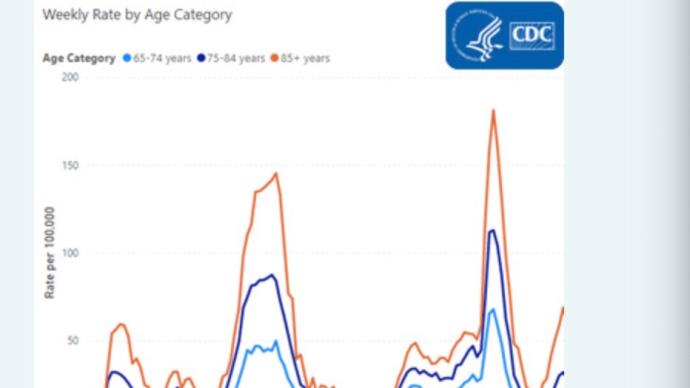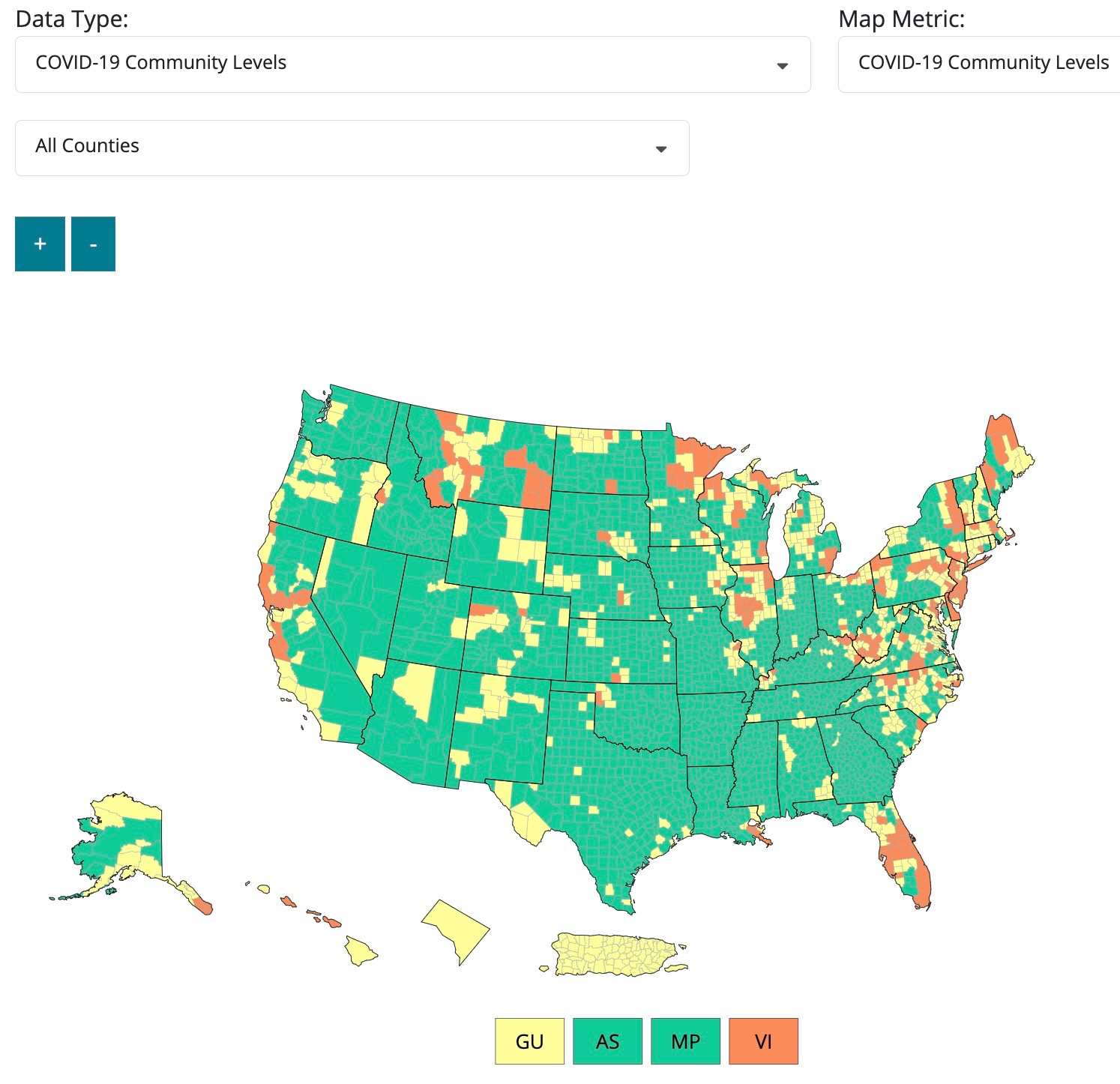
According to the weekly report on the new crown epidemic released by the US Centers for Disease Control and Prevention (CDC) on June 3, local time, the new variant BA.2.12.1 of Omicron with stronger immune escape ability has accounted for 59.1% of new cases in the United States. Compared with 1.5% two months ago, the proportion has increased by 39.4 times.
The CDC said COVID-19 cases are increasing across the U.S., but Covid-19 vaccination rates for children ages 5 to 11 continue to lag behind other age groups, putting them at increased risk of serious illness after infection. As of June 1, 2022, 35.9% of children aged 5 to 11 had received at least one dose of the COVID-19 vaccine, compared with 69.5% of children aged 12 to 17. Since the pandemic began, more than 4.8 million children aged 5 to 11 have been diagnosed with COVID-19 in the United States, 15,000 have been hospitalized, and nearly 200 have died.
In terms of the proportion of mutant strains, BA.2.12.1 reached 59.3%, far exceeding the previous highest proportion of BA.2. In New York and New Jersey, BA.2.12.1 accounted for 78.1%. It is worth noting that at present, CDC has classified the other two mutant strains BA.4 and BA.5 of Omicron, which also have super immune escape ability, under the B.1.1529 lineage, and the occupancy rate of the B.1.1529 lineage has increased from the previous week's 2.9% rose to 6.1% for the week, a surge of 110.3%.

 The United States just experienced the Omikron epidemic tsunami from last winter to this spring. The first half was BA.1, and the second half was BA.2. However, the infection of a large number of people and the high level of immunity of the population brought about by vaccination still cannot stop BA.2.12.1 from making waves again. Because of the mutation of the BA.2.12.1 spike protein, it has a super immune evasion ability.
The United States just experienced the Omikron epidemic tsunami from last winter to this spring. The first half was BA.1, and the second half was BA.2. However, the infection of a large number of people and the high level of immunity of the population brought about by vaccination still cannot stop BA.2.12.1 from making waves again. Because of the mutation of the BA.2.12.1 spike protein, it has a super immune evasion ability.
The mutation at L452 site of BA.2.12.1 spike protein is the spike protein mutation site that Omicron BA.1 and BA.2 sub-variants do not have, but the delta variant has. This means that under strong positive selection pressure, the Omicron variant has convergent evolution with the delta strain on the spike protein gene. The mutation on the spike protein is particularly noteworthy because the spike protein plays a key role in the entry of the new coronavirus into human cells: the spike protein can bind to the ACE2 receptor of human cells, invade across the cell membrane, and open the cell door. The "key" is also the main target of mRNA vaccine and antibody drug design.
BA.2.12.1 has a strong immune escape ability. The latest research from Ohio University in the United States shows that the neutralizing antibody in the serum of the recovered population after BA.1 and BA.2 infection and the serum of the population who received 2 or 3 mRNA vaccines were tested. The broad sub-variants BA.1, BA.2, BA.2.12.1 are more resistant. In addition to immune evasion capabilities, studies have shown that the spike protein of BA.2.12.1 has enhanced infectivity, processing capabilities, and cell fusion.
The CDC's weekly report shows that the positive nucleic acid detection rate in the United States was 11.7% that week, compared with 11% a week ago, an increase of 6.36%. The average daily number of nucleic acid tests in the week was 855,000, compared with 876,000 in the previous week. As of June 1, 2022, the 7-day moving average of daily new cases in the United States for the week was 100,684 cases, a decrease of 8.5% from the previous 7-day moving average of 110,081 cases. As of June 1, 2022, a total of 84,315,762 cases of COVID-19 have been reported in the United States.
CDC says U.S. coronavirus hospitalizations are on the rise. The current 7-day daily average of admissions for May 25-31, 2022 is 3,789, which is a 4.7% increase from the previous 7-day average of 3,619 for May 18-24, 2022. Hospital admissions for the elderly are starting to soar. Since the week ending April 2, 2022, the rate of hospital admissions for adults 65 and older increased from 6.7 per 100,000 people on April 2 to every 100,000 people on May 14, CDC data show. 24.3 people. Within this group, hospitalizations for those 85 and older increased the most, from 14.8 per 100,000 people on April 2 to 68.7 per 100,000 people on May 14.
The CDC said COVID-19 cases are increasing across the U.S., but Covid-19 vaccination rates for children ages 5 to 11 continue to lag behind other age groups, putting them at increased risk of serious illness after infection. As of June 1, 2022, 35.9% of children aged 5 to 11 had received at least one dose of the COVID-19 vaccine, compared with 69.5% of children aged 12 to 17. Since the pandemic began, more than 4.8 million children aged 5 to 11 have been diagnosed with COVID-19 in the United States, 15,000 have been hospitalized, and nearly 200 have died.
In terms of the proportion of mutant strains, BA.2.12.1 reached 59.3%, far exceeding the previous highest proportion of BA.2. In New York and New Jersey, BA.2.12.1 accounted for 78.1%. It is worth noting that at present, CDC has classified the other two mutant strains BA.4 and BA.5 of Omicron, which also have super immune escape ability, under the B.1.1529 lineage, and the occupancy rate of the B.1.1529 lineage has increased from the previous week's 2.9% rose to 6.1% for the week, a surge of 110.3%.


 The United States just experienced the Omikron epidemic tsunami from last winter to this spring. The first half was BA.1, and the second half was BA.2. However, the infection of a large number of people and the high level of immunity of the population brought about by vaccination still cannot stop BA.2.12.1 from making waves again. Because of the mutation of the BA.2.12.1 spike protein, it has a super immune evasion ability.
The United States just experienced the Omikron epidemic tsunami from last winter to this spring. The first half was BA.1, and the second half was BA.2. However, the infection of a large number of people and the high level of immunity of the population brought about by vaccination still cannot stop BA.2.12.1 from making waves again. Because of the mutation of the BA.2.12.1 spike protein, it has a super immune evasion ability.The mutation at L452 site of BA.2.12.1 spike protein is the spike protein mutation site that Omicron BA.1 and BA.2 sub-variants do not have, but the delta variant has. This means that under strong positive selection pressure, the Omicron variant has convergent evolution with the delta strain on the spike protein gene. The mutation on the spike protein is particularly noteworthy because the spike protein plays a key role in the entry of the new coronavirus into human cells: the spike protein can bind to the ACE2 receptor of human cells, invade across the cell membrane, and open the cell door. The "key" is also the main target of mRNA vaccine and antibody drug design.
BA.2.12.1 has a strong immune escape ability. The latest research from Ohio University in the United States shows that the neutralizing antibody in the serum of the recovered population after BA.1 and BA.2 infection and the serum of the population who received 2 or 3 mRNA vaccines were tested. The broad sub-variants BA.1, BA.2, BA.2.12.1 are more resistant. In addition to immune evasion capabilities, studies have shown that the spike protein of BA.2.12.1 has enhanced infectivity, processing capabilities, and cell fusion.
The CDC's weekly report shows that the positive nucleic acid detection rate in the United States was 11.7% that week, compared with 11% a week ago, an increase of 6.36%. The average daily number of nucleic acid tests in the week was 855,000, compared with 876,000 in the previous week. As of June 1, 2022, the 7-day moving average of daily new cases in the United States for the week was 100,684 cases, a decrease of 8.5% from the previous 7-day moving average of 110,081 cases. As of June 1, 2022, a total of 84,315,762 cases of COVID-19 have been reported in the United States.
CDC says U.S. coronavirus hospitalizations are on the rise. The current 7-day daily average of admissions for May 25-31, 2022 is 3,789, which is a 4.7% increase from the previous 7-day average of 3,619 for May 18-24, 2022. Hospital admissions for the elderly are starting to soar. Since the week ending April 2, 2022, the rate of hospital admissions for adults 65 and older increased from 6.7 per 100,000 people on April 2 to every 100,000 people on May 14, CDC data show. 24.3 people. Within this group, hospitalizations for those 85 and older increased the most, from 14.8 per 100,000 people on April 2 to 68.7 per 100,000 people on May 14.

Related Posts
0 Comments
Write A Comments